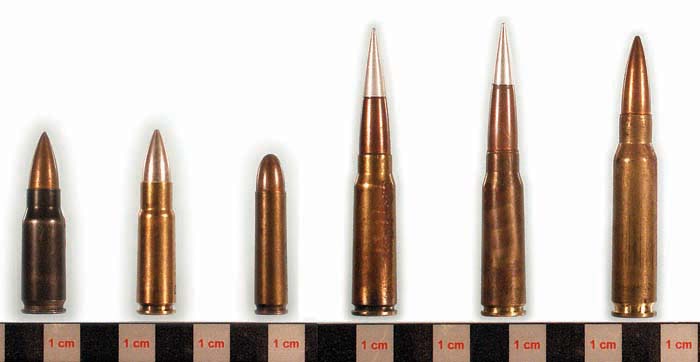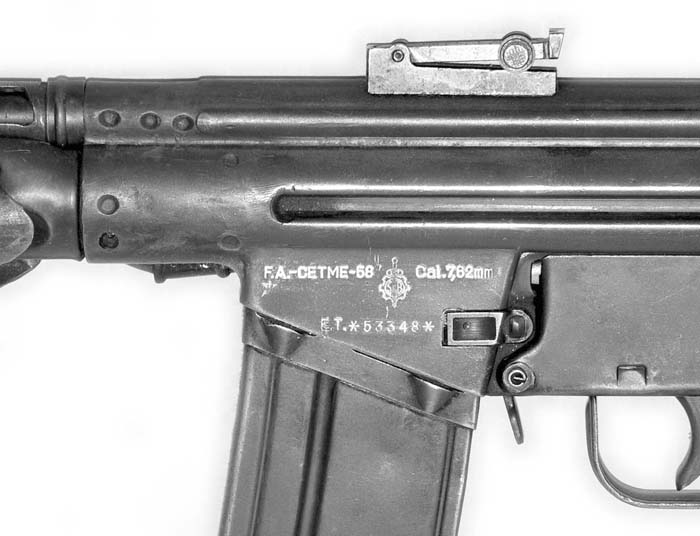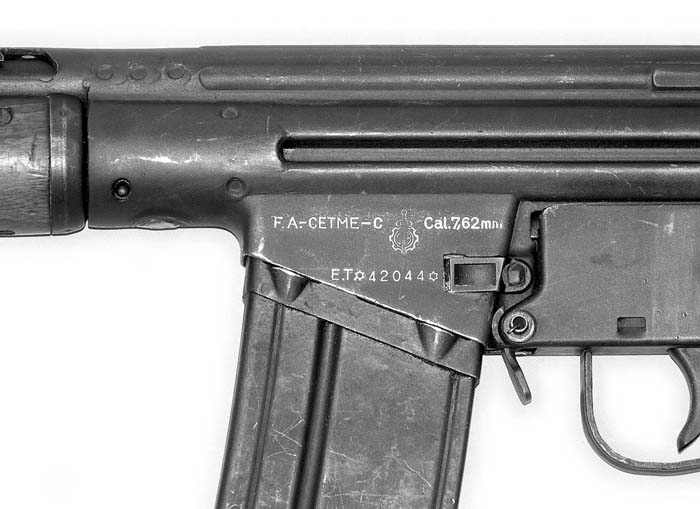The Modelo B is fitted with a bipod attached permanently to the handshield. (Jean Huon)
By Jean Huon
Before and during WW II, Germany developed several programs of assault rifles using conventional or intermediate cartridges:
- Mauser prototype in 7x39mm, with gas action at the mouth of the barrel like the G41.
- FG 42/I and FG 42/II used by airborne troops and shooting 7.92mm Mauser ammunition. But most of the other models used a single intermediate ammunition: 7.92mm Kurz.
- MKb or Maschinenkarabiner (automatic rifle) developed by Walther and Haënel, which produced the MKb 42(W) and MKb 42(H). After some improvements, the last was used as the MP 43, MP 44 and StG 44,
- other prototypes developed by Gustloff and Erma,
- StG 45(H) created by Haënel that looks like a StG 44 whose mechanism is reversed (cylinder below the barrel).
- StG 45(M), initially called Gerät 06H, this assault rifle was developed by Mauser. Its progress report would certainly have allowed its production during the summer 1945 if the war had continued.


But in April 1945, the allied Armies penetrated deeply in Germany and the hours of the Third Reich are counted.
An intact factory
General Leclerc’s 2nd Armored Division penetrates deep in the Black Forest and arrives on April 20th, 1945 at Oberndorf, a small town of the Wurttemberg area at the edge of Neckar. It is there that is established since 1872, the Mauser company. On their arrival, the French note that the production equipment is practically intact, although a certain number of machines, plans and prototypes were evacuated towards the Austrian Alps in a railway train that the Allies captured on June 1, 1945.
The war is completed in Europe, but the French Army must be rebuilt and be reequipped. Although France profits from the American assistance, it has lost much at a great cost and headquarters looks about the Mauser factory who could ensure assembly of weapons which are lacking to French troops; especially as the war continues in Asia and Indo-China should be reconquered.
The factory is then managed by a French officer, Major Michon, who supervises a German director, Doctor Harnisch. The French gave orders to Mauser to assemble under their control a variety of small arms from spare parts held in stock:
- 51,000 P38 pistols
- 18,000 to 20,000 HSc pistols,
- 1,000 W.T.P. pistols,
- 3,000 Lüger P08 pistols,
- 48,115 K98 k carbines.
The research department is also reactivated and develops a .22 Long Rifle rim fire repeating carbine for training. It was adopted as the Mauser Modèle 45 and later became the MAS 45. Other prototypes were also developed.
But the use of Mauser factory by the French is not well appreciated by the Soviets who protest and order the destruction of the factory.
Before the factory buildings were destroyed in July 1946, the French took care to recover many prototypes, drawings and machines that were dispersed to various factories in France. The DEFA (Direction des Etudes et Fabrications d’Armement) now managed all research. The German research department from Mauser (138 engineers and technicians “under contract”) was invited to follow the tools to France.
Transfer to Mulhouse
In Mulhouse (Alsace), a team of German technicians placed under the direction of MM. Vörgrimmler, Löffler and Kunert continue the research.
The establishment where they work is installed in a former artillery shell factory. It becomes the FOMHAR and its activities are divided into two specific branches: the stamping of artillery shell and the study of prototypes of small arms.
In 1947 or 1948, the company name of the establishment is modified and it becomes the Centre d’Etudes d’Armement de Mulhouse (CEAM), and is then changed again in 1952 to Atelier de Fabrication de Mulhouse (AME).

The small arms branch of the Mulhouse establishment concentrated their work on several projects that included pistol, submachine gun, automatic carbine, semiautomatic rifle, assault rifle, light machine gun, big bore machine gun and automatic cannons (20 and 30 mm) until the closing of the establishment in 1967.
It is interesting to note that the preponderance of the documents examined in the files of the AME (technical notes, correspondence, drawings, etc.) are very often written in German.
The majority of the produced light weapons use a mechanism derived from that of StG 45(M), with a mobile breech with delayed opening and semi-rigid locking by side rollers. This mechanism appears on a 7.92mm Mauser semiautomatic rifle resembling the G 43, a carbine in .30 M1 and particularly an assault rifle which precedes already what will become the CETME rifle.
The weapon is fitted with a collapsible stock whose design is close to that of the MP 40. The cylindrical frame is lengthened with a perforated cooling jacket that contains the barrel and a tube that receives the bolt carrier. The cocking handle is located on the left and it is directed upward at a 45 degree angle. The operating parts comprise a bolt carrier, a mobile head with two locking rollers and a striker carrier. The barrel is screwed in a ring where it also locks the bolt. A box contains the trigger mechanism and receives the pistol grip. The weapon is fitted with a bipod and is fed by a detachable curved magazine introduced through the bottom.
The first model is completed in November 1948, and fires an intermediate cartridge of the 7.65mm Model 1948 (7.65×35). It is followed a short time later by other versions in .30 M1: carbines CEAM Type 1950 A and B. A report/ratio of test dated May 3, 1950 shows that these versions functioned normally, but that one had not been able to cure a problem of bolt bounce at the time of closing. On the following models, a braking pawl solved the problem.
The rifles/machine guns in .30 M1 are developed until 1950. Then the French Army changed direction and is interested in assault rifles firing a conventional cartridge. Although the program officially appears on July 10, 1952, the first prototypes were developed in 1951.


Spanish Recruitment
Meanwhile, the Spanish military authorities created in 1949 the Centro de Estudios Tecnicos de Materiales Especiales or CETME, placed under the direction of General Cantero and they seek to enlist the services of German technicians. Ludwig Vorgrimmler is contacted but the French refuse to deliver a passport to him and he leaves France clandestinely for Spain. He arrives at CETME in Madrid on June 1, 1950 and it is there that he finds fellow engineers that worked in all of the German armament industry, including engineer Heynen.

To answer a military requirement program, CETME was charged to study and develop an assault rifle having the following characteristics: maximum weight 4.5 kg, possibility of selective fire and a shooting range of 800 to 1,000 meters. The need was a rifle having the same weight and recoil as the StG 44 but shooting at double the range.


The first prototype is made but encounters numerous problems. Many parts are hand made with makeshift solutions. For example, the magazines are hand made with sheet metal recovered from oil barrels.

One year later, the prototype is finally ready and it is presented to General Franco. It is followed of a preproduction run of 30 weapons and new ammunition was developed by the Palencia cartridge factory. These special ammunitions have an extraordinarily long projectile. The stability of the bullet (very light for speed), is obtained by the use of an aluminum core and a copper jacket. This ammunition was made in two versions and was developed by Dr. Voss and his collaborators: 7.92×40 and 7.62×40.
CETME developed the Modelo 1, an experimental rifle, which employed the 7.92×40 cartridge. This rifle resembled much of the weapons developed in Mulhouse. The French establishment will continue on its side the development of assault rifles based on the same principle until 1960. Modelo 1 functions with gas action. Its mechanism is thickset and it is fed by a curved 30-round magazine.
The Modelo 2 in 1952, again in 7.92×40, with a refined silhouette, finds an operation similar to the CEAM Type 1950 rifle, with a delayed opening bolt and semi-rigid locking by side rollers.

CETME now relied on several subcontractors and coordinated the production and the final assembly of the weapons for testing. To conclude the project, they called upon other arsenals and specialized companies in mechanics, stamping and aeronautics for assistance.
The Spanish tests revealed a very good performance with light recoil, flat trajectory, good precision and an excellent capacity of penetration with a helmet being pierced at 1,000 meters. Some of the results equaled those obtained by a machine gun: a good shot would have a 50% chance to achieve a hit placed at 1,000 meters with a one-second burst of 9 shots.
Other countries were interested in the CETME rifle, particularly the Federal Republic of Germany. The German Ministry of the Interior was very interested in the CETME rifle to equip its police forces. However, a condition that had to be met was in regard to the ammunition: the 7.62mm NATO cartridge had to be used.
The bolt mechanism of the new rifle allows the use of ammunition with variable power by varying the angle of the bearing surfaces of the locking rollers.
The Spaniards then developed a rifle known as the Modelo A as an alternative of the Modelo 2; supplied with a slightly curved magazine. The rifle now has a carrying handle and preserves the folding hand-shield being able to be used as bipod. The weapon fires from now on a 7.62×51 cartridge with a reduced load called 7.62mm CETME-NATO, associated with a light bullet fitted with a mixed core (plastic and lead).
The firm of Madrid yields the production license of its assault rifle to the Dutch company NWM, which then undertakes to carry out demonstrations abroad. Tests take place in Germany, Chile, United States, France, Netherlands, Philippines and Portugal.
After a short time, the CETME rifle is again presented in Germany. At this time the Defense Ministry is interested in order to equip the new German Army because the FN refused to yield to them the license to produce the FAL (G1). Several rifles were tested: SIG SG 510-4 (G2), CETME (G3) and AR-10 (G4).
Altered, the CETME Modelo A became Modelo B, which was adopted in Spain in 1958. The weapon is fitted with a perforated jacket which extends the frame, a bipod and a tangent sight. The magazine is slightly curved and there exist two types of magazines of 20 or 30-round capacity. The pistol grip is metal with plastic inserts. From now on, it functions with a closed breech, both for single shot or burst fire, which was not the case of its predecessor.
Come Back Over the Rhine River
Germany, which was interested in work of CETME since 1954, adopted this version in 1959 under the name of G3. The license for commercial sales held by NWM (a Dutch firm) for all the countries except Spain, Portugal and Germany is repurchased in 1960 by the German government. Manufacture is entrusted to a group of German industrialists and the final assembly and the control of work of the program are assured by the company Heckler & Koch; a young company of former employees of the Mauser Company that manufactured components for sewing machines.
The Germans improve the G3 by modifying the operating system, the recoil spring is reinforced and the weapon can now fire the 7.62mm NATO standard ammunition.
Collaboration between CETME and H&K (sealed by two agreements between the two governments in 1959 and 1962) continues and in 1964, CETME introduces Modelo C, which is practically identical to the G3 firing the 7.62mm NATO standard ammunition. The two weapons now have a wooden hand guard and the bipod disappeared. The Spanish weapon is equipped with a rear sight with four eyepieces on a rotary rise in the vertical plan, while the G3 has a formed rise of an oblique drum to a bead and three eyepieces, rotary in the horizontal plane.
The CETME was the link that ensured the connection between the prototypes developed in Mulhouse starting from the StG 45(M) to the G3. The Modelo C was produced until 1976.
CETME Modelo C
The CETME Modelo C is in 7.62mm caliber and the barrel has 4 right-hand grooves with a pitch of 305mm (against 240mm on the Modelo B) and a flash hider/grenade launcher is screwed on to the muzzle.
The receiver frame is made of sheet metal worked by successive passages in presses, then welded partly low in the median plane. Under the frame is a case joining together the trigger mechanism and the magazine well. The pistol grip is made of plastic, fixed with a longitudinal screw.
The selector switch is located at the upper part of the pistol grip, on the left and marked from the top downwards with T (single shot), S (safety) and R (burst).
These controls are different from those of the G3 which is marked from the top to downwards with S (safety), E (single shot) and F (burst).
The supply of ammunition takes place by means of magazines. For the CETME, there exist two types of magazines: one of 5-rounds for garrison service and one of 20-rounds for combat.
The cocking lever folds and is placed on the left side guide tube located above the gun.
The bolt group is made of several elements which are: the bolt body, locking piece, locking rollers and bolt-head. The recoil spring is at the back of the bolt body.

Sights are composed of a protected front sight and a rear sight with four revolving blades graduated for 100, 200, 300 and 400 meters. The blade for shooting at one hundred meters has a bead out of V to facilitate instinctive shooting. The other blades carry an eyepiece.
The forearm is made out of wood of poplar, but on request Modelo C could also receive a perforated metal jacket with a non-removable folding bipod like the Modelo B.
The stock is also made of poplar and is fixed at the back of the frame by a metal support and contains the buffer. The connection between the stock holder and the frame is ensured by two metal pins that also ensure the fixing of the trigger mechanism case.
Accessories
- Removable and folding bipod with telescopic legs, it is mounted on the ring holding the front sight. It makes the rifle able to shoot in a 17 degree horizontal sector and 7 degree vertical.
- Cleaning kit located at the front of the cocking lever guide tube. It is contained in an aluminum tube fitted with a screwed plug and is composed of a flue brush and a rag holder with string.
- Scope for day shooting.
- Philips infra-red night scope.
- Blank firing attachment
- Fabric protective cover.
- Plastic plug for the barrel mouth.
- Carrying sling.
- Magazine loader.
- Bayonet with 22.5 cm (8.86 inches) blade. The handle has squared black plastic platelets. The scabbard is of olive plastic with khaki nylon belt holder.
Disassembly
- Remove magazine and visually check the chamber make sure gun there is no cartridge in the chamber.
- Extract the two pins that affix the stock to the receiver and place them into the two tubular rivet receptacle holders in the stock.
- Remove the stock and the recoil spring.
- Hinge down the pistol grip assembly.
- Using the cocking lever, retract the bolt assembly.
- To remove mobile breech, bring the head of the breech forward and to make it swivel 180 degrees.
- Remove the head of the breech.
- Turn the striker holder and withdraw it.
- Extract the striker and its spring.
- The reassembly is carried out in the inverse order
CETME continued the development of individual weapons and created Modelo D and Modelo E rifles, which were improvements of the previous models but were not adopted. It then developed the Modelo L, a weapon firing 5.56×45 ammunition. The development of this weapon began in 1966 and was adopted in 1980 for the Spanish Army.
CETME also developed the AMELI, a mini MG 42 also shooting the 5.56×45 ammunition.
In 1996, the Spanish Army opened a contest for the adoption of a new 5.56mm assault rifle and tested the following weapons: HK G36 E (Germany), Steyr AUG 77 (Austria), FNC (Belgium), Diemaco C-7 (Canada), Galil (Israel) and SIG 550 (Switzerland). In 1999, the G36 E is chosen.
CETME Modelo C
Caliber: 7.62mm
Ammunition: 7.62mm NATO
Overall length: 1.015 m
Barrel length: 0.305 m
Weight unloaded: 4.200 kg
Magazine capacity: 5 and 20 rounds
Cyclic rate of fire: 550-650 rpm
| This article first appeared in Small Arms Review V11N7 (April 2008) |










